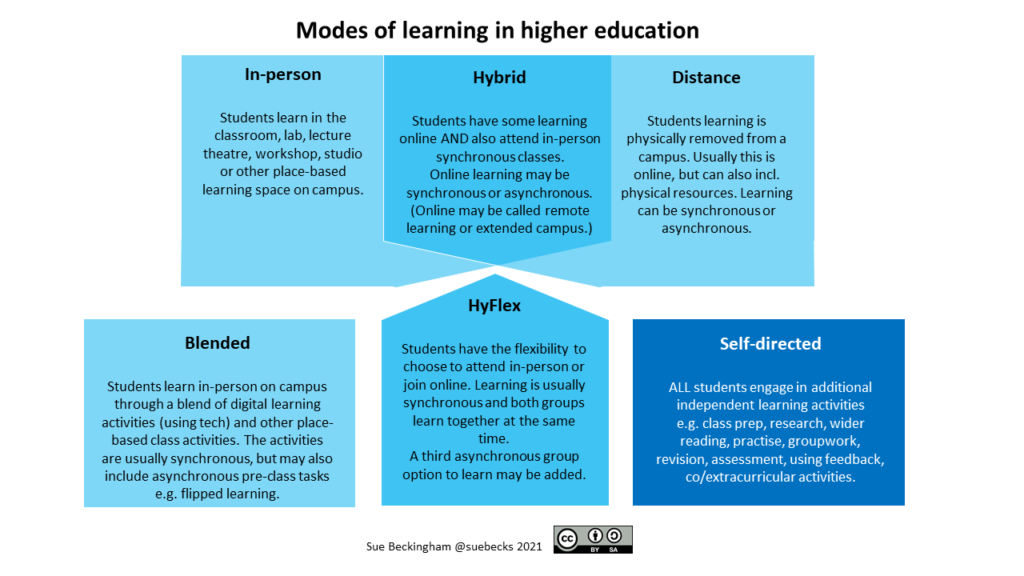I refer to the SPaM framework as being in support of the development of Hybrid Education/Learning and one of the queries I get is why use the term hybrid over blended, what’s the difference?
In the context of SPaM I will attempt to set out why I have chosen to use the term hybrid over and above any other term, but in all honesty no matter the terminology, SPaM is still useful as reference point for fully on campus / blended / hybrid / fully online course development as fundamentally it is about consciously thinking about and making decisions around each of the framework domains.
(Oh and as side note I have also heard people question why I use “in-person” in reference to just on campus teaching because after all isn’t online synchronous also in-person? Well the main reason is because that is what the dictionary definition is, so I hope we can agree on that one at least!
in-person
adjective
(of an activity or event) taking place with people physically present together in the same place, not on the internet or by phone or video link
So with that out of the way, let’s down to the slightly more complex discussion about defining “hybrid”. What I’d like to do is start with why I’m not using the term blended. Part of the reason for this is because we just haven’t really ever managed to get to an agreed definition of what we mean by that either (and I suspect the same will be the case for hybrid), but I do think Sue Beckingham’s work (as seen in the modality section) is really helping to clarify those differences of opinion in relation to terminology and at least starting to get to a consensus of definition, even if some won’t always agree.

As you will see from that model Beckingham has provided a definition for both blended and hybrid, both of which I am pretty comfortable with, but not everyone will be. The basic premise is that ‘blended’ is a mode that is predicated around an on campus setting, using digital tools and platforms to support that experience, whereas ‘hybrid’ is predicated on learning experiences where students have aspects of their learning taking place on campus and online.
Now on the surface of it some may think that that sounds pretty much the same, but the key difference for me is that in hybrid education the curriculum is specifically designed for each mode, that means decisions about the pedagogy (including assessment design, learning activities, feedback methods etc) are all specific to the mode (this is exactly what SPaM encourages).
Also personally when I think of blended I visualise lots of ingredients in a food processor being whizzed round together – and I wanted something that represented a more structured approach.
The best analogy I have relates to a hybrid vehicle. A hybrid vehicle has both a combustion engine and electric motors. For some journeys the combustion engine is the most suitable, usually for travelling long distance or at high speed for long periods. For other journeys the electric motor will be most effective, usually those shorter runs, in urban areas and where maximum efficiency can be gained. There is also an intrinsic link between the combustion engine and the electric motor, with the former charging the batteries for the other and conversely the electric engine providing extra horse power for when the combustion engine needs it. Ultimately what we have here is a system designed for maximum flexibility, combining the benefits of both.
So, if we apply that same concept of ‘hybrid’ to education, what we should be doing is thinking about the student learning journey and designing the curriculum using different modes for different elements of that learning journey, making decisions about which mode is best for which elements of learning. At a programme level it may be that certain modules are best for certain modes, or within a module certain topics/activities are best for a certain mode. These are not decisions for me, but for those charged with the design of the programme/module, using SPaM as a point of reference for these discussions and decisions.
So, that’s the rationale for why I am using the term ‘hybrid’ – not everyone will agree with it, but firstly it is based on established use of the term, albeit outside of the education sector which in my opinion makes it less likely to be misunderstood and secondly this definition has gained traction (in the UK at least) over the past few years as we rethink our approaches to learning and teaching in response to the Covid-19 pandemic.
I have no doubt that the term ‘hybrid’ will continue to be debated for many years, as we have seen with the definition of blended learning and this is to be expected as both technology, pedagogy and the scholarship of learning and teaching evolve.
All we can do is seek to clarify these terms in the context of our own work so that those who engage with this framework and it’s use understand the framing of the terminology around which it was developed. So, whether you agree with this definition or not (and I’m happy to debate it), at least you have a better sense of what it means in the context of the SPaM framework and why I am using it.

